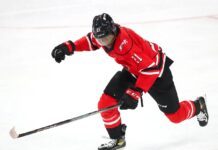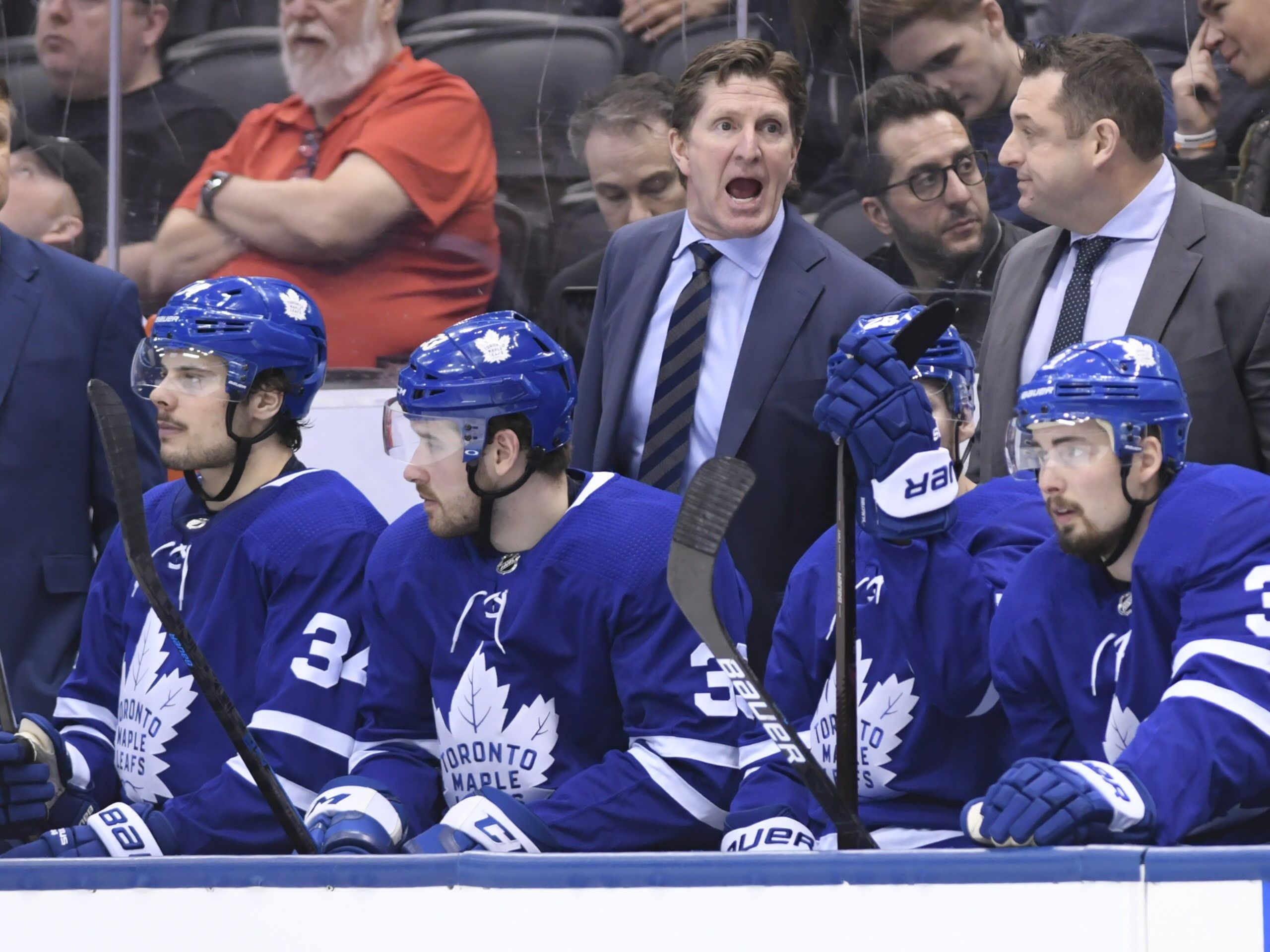First, let’s start with a thank you.
Thank you for following along with us all season, reading, commenting, sending us your emails, posting comments on social media, and however you followed along/engaged in this space. We really do appreciate it and it is part of why I love all of this so much – all of you that take the time to read and interact with what we have to say. To me, it makes it worthwhile and while I do not always respond in the comments section, rest assured I do read every comment on Notebooks and give your observations and considerations some time and critical thought.
Now, let’s get to hockey.
This was the first time since 2003-04 that the Leafs entered the season with legitimate expectations and Cup hopes. Already armed with a collection of young talent, they signed arguably the biggest free agent of the post-lockout era and with that came excitement and energy throughout the city.
To be honest, though, the team rarely felt like a well-oiled machine, with everyone clicking in a way that made me think they were actually ready to go on a long playoff run. The reasons for that were pretty simple: The defense was still a poor unit and the forwards never really gelled as an overall group as the third and fourth lines didn’t really complement the top of the lineup — in particular, the third line never really found its purpose.
Going into the playoffs, I predicted the Bruins to win, as did most people, and there were a lot of comments that essentially said, “There will be a lot of egg on everyone’s face if the Leafs win the series.” The truth is, though, the Leafs didn’t play at a level in the regular season that would suggest they should beat the Bruins – compared to Boston, they had a worse team corsi, fenwick, power play, gave up more goals against per game, and had the exact same penalty-killing percentage on the season. The only thing the Leafs had over Boston was a higher goals per game output, and since when is playoffs about high-scoring, firewagon hockey? They were right there in the series and through five games, and I thought they were the better team overall, but in the last two games, Boston was the better team. In Game 7, other than a push in the second period from the Leafs, it never really felt in doubt.
Without further ado, let’s get into some storylines heading into what is going to be a really interesting summer as the Leafs try to finally get over the hump after losing in the first round of the playoffs three years in a row now.
On Mike Babcock’s 2018-19 Season and Team Depth
The Leafs lost in seven games to a team that tied for the second most regular-season points in a year where every division winner lost in the first round (because the playoffs are hard!), and yet there was a somewhat surprisingly loud chorus of calls for Babcock’s head.
Part of the speculation was brought on by Kyle Dubas, who did not exactly give his coach a ringing endorsement. His first words about Babcock’s future were as follows:
I think the way I look at that is that Shanny has to decide on me first and do an evaluation of me, which I think any organization would be best to do. Once that is done, we evaluate everybody. We could win the Stanley Cup and it would be the same discussion of evaluating where we are at and are, we content and are we moving in the right direction? I think with how fluid the situation is, I wouldn’t give any guarantee to anybody in our whole organization, starting with me. We will do what we think is best and we will let you know when we know, but that is my expectation.
It’s a political answer, and I completely understand the sentiment behind it and what he’s saying, but it’s a far cry from the, “We can, and we will” Dubas delivered when asked about re-signing his top young players. Any way you want to slice it, it’s not a ringing endorsement of the coach and something is clearly rotten in the state of Denmark. The signs unequivocally point to at least some dysfunction in the relationship (although you can’t exactly expect two people to see everything the exact same way all the time).
There are some legitimate gripes and I think we will see some changes that point towards that this summer. Elliotte Friedman reported that Jim Hiller has permission to interview with anyone and is not expected back. Hiller was brought over from Detroit by Babcock and that’s a clear “taking a piece away” move, although it’s justifiable considering he was in charge of a power play that was beyond disappointing considering the talent at his disposal. DJ Smith is interviewing around and could be gone as well. The identity of the new assistant(s) will be rather telling (i.e. who hired them?).
On Babcock’s end specifically, there has been some — let’s say — stubbornness. Three years into their careers, we have rarely seen Auston Matthews and Mitch Marner play together, yet he put them together in Game 7 when they needed some offense. This was not a hard thing to see coming; we knew all season this would be something that they would need to go to in times of desperation, and yet they played 114 even strength minutes together this season. They have had nice moments together on the power play, but we have seen very few flashes of brilliance at 5v5 and they haven’t been given any rope to figure it out. Either they have been paired up in the third period of blowouts or given the odd game or two before pulling the plug. That’s not setting them up for success.
Looking around the league, I can’t think of a single team that doesn’t unite their top players throughout the regular season. Boston obviously has all three together, Tampa has had Nikita Kucherov with both of their top centers over the past few years, and even Pittsburgh unites Sidney Crosby and Evgeny Malkin (these examples are common throughout the league). The Leafs do not do this, though, and let’s make this as simple as possible: When the stakes are highest, wouldn’t you want your two best players playing together? The answer, of course, is yes.
In general, there has been a reluctance to mix things up and it has been the case for years. “Here are your linemates at the beginning of the season, you will be playing with them throughout the season unless there is an injury and I have to change things,” is essentially how the forwards have been deployed.
This year, it particularly hurt Nazem Kadri, who was put in a sheltered third-line scoring role with his most frequent linemates being Patrick Marleau and Connor Brown – counterintuitive, to be sure. This also came years after being a successful matchup center and frankly, there were many games this year where Kadri was just unnoticeable and largely just disengaged. The coaching staff never really found the right mix among the forward group and they rarely did enough testing to truly find the right combination.
There has also been a puzzling reliance on veterans. The main standout here is, of course, Patrick Marleau. To some degree, Mike Babcock is in a tough spot. It has repeatedly been indicated that Marleau’s consecutive games played streak is important to him and it would be very difficult to go to him in the regular season with a playoff spot all but locked up relatively early and ask him to sit to preserve himself.
In the 2019 calendar year, Marleau played 43 regular season games and scored six goals and 17 points followed by two assists in seven playoff games, so that’s 19 points in 50 games for a player who received roughly 15 minutes a night (a little higher in the regular season, a little lower in the playoffs). In the playoffs, Marleau put eight shots on net and was generally not dangerous. It’s a tough conversation with a player who has had such a storied career, but at some point, you have to sit there and have an honest conversation that goes something along the lines of, “We are prioritizing winning and this is what has to happen.”
What highlighted it even further is that the Bruins had a similar-ish situation with David Backes. He isn’t as accomplished as Marleau in his career, but he has been a captain, he has been an Olympian, and he is signed for big money and term. The Bruins healthy scratched him multiple times throughout the season and playoffs when they felt the need to. While the argument isn’t necessarily that Marleau should be a regular healthy scratch, at a minimum, he should have seen fourth-line duty at times because he was generally unimpactful and they had players in Trevor Moore and Tyler Ennis that showed more signs of life. That is on the head coach. It’s not easy, but that’s why they get paid so much.
Further dysfunction is seen clearly with the Nic Petan trade. It’s a minor move, but he dressed for five games after the trade and Babcock clearly had little interest in playing him, particularly after the one game in which he tried him at center and promptly came out in the post-game interview and announced it wouldn’t be happening again. After the playoffs, Babcock mentioned the lack of depth in the organization and he’s not necessarily wrong to do so even though Dubas has improved the team with the acquisitions of John Tavares and Jake Muzzin.
In the playoffs, the Leafs’ bottom six of Patrick Marleau, William Nylander, Connor Brown, Trevor Moore, Frederik Gauthier, and Tyler Ennis accounted for two goals scored. One of those players was used on the penalty kill and neither line could be trusted defensively in a defensive zone specialist or shutdown role. The Bruins bottom six accounted for six goals and they used multiple players in defensive and penalty killing roles. This was a theme discussed throughout the season here – they had no diversity throughout their lineup; it was quite literally just a much worse version of their top six. The Bruins, with actual roles, rolled their lines more and didn’t have a fourth line playing under seven minutes per game.
Babcock wasn’t wrong to mention the depth; they need some, and they need some diversity through this lineup.
Ironically, they also need some center depth throughout the organization because once Nazem Kadri was suspended (more on him another day), they only had one real option – William Nylander. Their fourth line center had zero hope of moving up the lineup. Gauthier would have been caved in should he have been entrusted with that responsibility. On the Marlies, you can maybe make a case for a center or two (most likely Adam Brooks), but there is no option that you can absolutely feel good about at this time.
This is the third season in a row there has been a problem at the 4C hole. In year one, the team traded a second round pick for Brian Boyle before trading a second round pick for Tomas Plekanec the following year. In year three, they signed Par Lindholm and it ended up being Frederik Gauthier in that spot. They probably didn’t want to continue giving up high draft picks for a depth player, which is justifiable, but how many years in a row can this half measure approach take place in the summer that then leads to them sitting there at the deadline and thinking to themselves, “Who can we get so we have a real NHL center at the 4C hole?”
On defense, it should be noted that Jake Gardiner — and we’ve since learned Travis Dermott as well — were playing while pretty badly injured, greatly impacting the team’s depth on the blue line (we could quibble with whether Babcock gave Justin Holl enough of a chance to establish a foothold in the league this season to be an option come playoff time, but those two things were obviously major factors on defense and were outside of his control). Both players playing despite significant health concerns is a clear indication of the coaching staff’s level of belief in any of their depth options.
Stylistically, the team still relies on stretch passes and rush offense to create chances more than anything else. While they were eighth in team corsi, they were 14th in team fenwick and they led the league in missed shots. I don’t want to say they game the system, but they do throw a lot of junk towards the net and nobody is going to confuse them with a team that dominates the offensive zone and tilts the ice.
In the playoffs, the Leafs showed legitimate flashes of tight, controlled breakouts where they moved the puck up ice as a unit, which was encouraging. But where was that throughout the regular season, particularly in a dreadful March? In 2019, they were 20-17-6 with a +2 goal differential and their 46 points were tied for 18th. For whatever reason, they didn’t look good, and that has to be addressed. This isn’t a veteran team that can coast into the playoffs; they have accomplished nothing and they need to earn that benefit of the doubt.
All of this said, it would not have made much sense for Kyle Dubas to fire him, if for no other reason than for Dubas’ own sake. The reality is this is a business and everyone is on a life cycle. If the Leafs falter again next season (another first-round exit, barring extenuating circumstances), Dubas can fire Babcock and then bring his own coach in no questions asked, buying himself some time. If he fired Babcock this summer, the pressure shifts right onto him and this would be his team with no excuses. By keeping Babcock, he buys himself an additional year, if nothing else.
I also don’t think it sends the right message to fire Babcock, essentially blaming him for the first-round loss. There were more than a few no-shows in the series and at best we can generously say only a handful of players can be happy with their Game 6 and 7 performances. And that’s on them.
This is the biggest market in hockey with a collection of young all-star talent on it; there’s more to coaching this team than setting the lines and roles. There are very real emotions and egos involved and I don’t think this group is particularly easy to manage considering all of the personalities. We have seen just a slight public glimpse of it with their contract negotiations. What would the mentality be if the young players were easily able to get such an accomplished coach fired and be completely absolved of blame for losing in the playoffs in the process?
Over the coming weeks, I will be reflecting on multiple topics regarding the Leafs. Next up will be Nazem Kadri, William Nylander, and the defense.
































